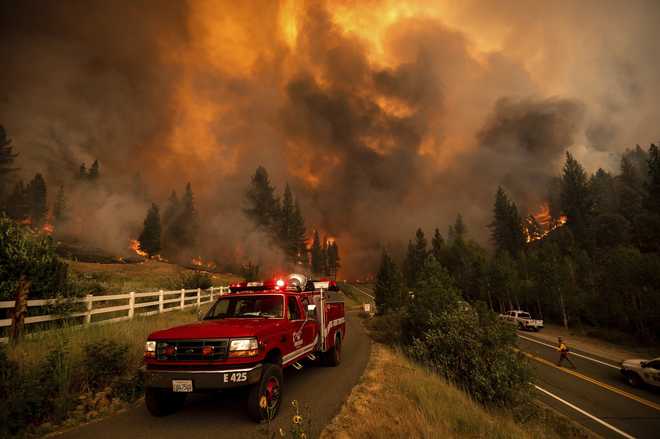
Seventeen years ago, when Adriana Nichols moved from New York City to Los Angeles, she had a simple wish list: natural light (her New York studio apartment was dark), a yard and quiet neighbors. She managed to check everything off that list — and has spent nearly two decades living in the canyons of LA.But today, as she looks to move again with her husband, her requirements have changed."It is profoundly a different wish list. A place where we have water, where we are not... having bags packed in case fires evacuate us," said Nichols.Video above: UN scientists signal “code red” warning about the future of climate changeIn the last few years, Nichols says the California wildfires and poor air quality make living there unappealing — and downright scary.But she says nearly every place she looks to move to is experiencing some element of climate risk. And a new analysis by Redfin, a real estate brokerage, reveals more Americans are moving into areas that face the highest climate risks than ever before.Redfin analyzed data from ClimateCheck, a real estate climate risk assessment provider, and the U.S. Census, which showed that of the top 50 U.S. counties facing climate risks in heat, storms, drought, flood and fire — the majority saw an increase in population over the last five years.Counties with homes facing the highest heat risk saw populations increase by an average of 4.7% over the last five years. Counties with homes facing high drought risk saw population growth of 3.5%, fire risk counties grew by 3%, flood 1.9%, and storm 0.4% over the last five years.Meanwhile, places with relatively low climate risks have experienced population declines. The 50 counties with the lowest number of homes facing heat risk, for example, saw a population loss of 1.4% in the last five years, according to Redfin.Counties around New York City and Chicago — both in states that were already leading the U.S. in population decline — only lost more people during the pandemic when homebuyers left metro areas in exodus, according to Redfin."Counterintuitively, people are moving to places with higher climate risk," said Daryl Fairweather, chief economist at Redfin. "And it seems like climate, although it's something that people care about, is at the bottom of the list or it's not the top priority."For example, migration to Wasatch County, Utah, just outside Salt Lake City, is up almost 15% in the last five years. But Wasatch County has the third-highest fire risk in the U.S., with 96% of the homes there at risk, according to Redfin. The area became even more popular in the last year amid the pandemic, with people looking for affordability, more space and proximity to the outdoors."2020 saw some of the worst wildfires we've ever seen in Utah," said Ryan Aycock, agent and market manager for Redfin in Salt Lake City. "I don't necessarily believe that it's going to slow down the people moving into the area. It's still extremely affordable. It's still a very desirable place to live compared to a lot of places."Affordability appears to be a big factor. Of the 50 counties with the largest share of homes facing high heat and storm risk, more than half had a median sale price below the national average of $315,000, Redfin found.'Nothing will deter them'Williamson County, Texas — part of the Austin metro area — has the highest heat risk in the U.S., yet it's the county with the biggest growth in population, at 16.3% since 2016, according to Redfin."People live in San Francisco or New York for the most part because it's where they are able to advance their careers the most, but now Austin is starting to rise as a tech hub and Austin has climate risk," said Fairweather.It's also where people are buying their second homes — followed by Florida, where homebuyers are taking advantage of lower taxes, said Scott Durkin, CEO of Douglas Elliman."I think people continue to put in the back of their minds. I think there are people that will do anything to be on the ocean and the coast of Florida and nothing, nothing will deter them," said Durkin.That's despite a record-breaking Atlantic hurricane season last year. And the National Oceanic and Atmospheric Administration (NOAA) is predicting a 60% chance of an above-normal hurricane season again this year, with Florida often a target.Still, home sales in Palm Beach and Miami, are up 270% and 133%, respectively, since last year, according to Douglas Elliman.During the pandemic-fueled red-hot housing market, many buyers waived home inspections to beat out other buyers, according to Durkin. However, in climate temperate areas, Durkin advises against that."If you've got something that has the elements of the strong weather or... subject to heavy winds and waves breaking and beach erosion, you have to really think twice. You may want to get the inspection on the way in before you even negotiate, just so you know for yourself," said Durkin.As for Nichols, she wants to be out of her Los Angeles home in a matter of months."It's no longer a question of, 'Where do we want to live?' The question has become, 'Where can we live in relationship to what's happening there climate-wise?'" said Nichols.
Seventeen years ago, when Adriana Nichols moved from New York City to Los Angeles, she had a simple wish list: natural light (her New York studio apartment was dark), a yard and quiet neighbors. She managed to check everything off that list — and has spent nearly two decades living in the canyons of LA.
But today, as she looks to move again with her husband, her requirements have changed.
"It is profoundly a different wish list. A place where we have [running] water, where we are not... having bags packed in case fires evacuate us," said Nichols.
Video above: UN scientists signal “code red” warning about the future of climate change
In the last few years, Nichols says the California wildfires and poor air quality make living there unappealing — and downright scary.
But she says nearly every place she looks to move to is experiencing some element of climate risk. And a new analysis by Redfin, a real estate brokerage, reveals more Americans are moving into areas that face the highest climate risks than ever before.
Redfin analyzed data from ClimateCheck, a real estate climate risk assessment provider, and the U.S. Census, which showed that of the top 50 U.S. counties facing climate risks in heat, storms, drought, flood and fire — the majority saw an increase in population over the last five years.
Counties with homes facing the highest heat risk saw populations increase by an average of 4.7% over the last five years. Counties with homes facing high drought risk saw population growth of 3.5%, fire risk counties grew by 3%, flood 1.9%, and storm 0.4% over the last five years.
Meanwhile, places with relatively low climate risks have experienced population declines. The 50 counties with the lowest number of homes facing heat risk, for example, saw a population loss of 1.4% in the last five years, according to Redfin.
Counties around New York City and Chicago — both in states that were already leading the U.S. in population decline — only lost more people during the pandemic when homebuyers left metro areas in exodus, according to Redfin.
"Counterintuitively, people are moving to places with higher climate risk," said Daryl Fairweather, chief economist at Redfin. "And it seems like climate, although it's something that people care about, is at the bottom of the list or it's not the top priority."
For example, migration to Wasatch County, Utah, just outside Salt Lake City, is up almost 15% in the last five years. But Wasatch County has the third-highest fire risk in the U.S., with 96% of the homes there at risk, according to Redfin. The area became even more popular in the last year amid the pandemic, with people looking for affordability, more space and proximity to the outdoors.
"2020 saw some of the worst wildfires we've ever seen in Utah," said Ryan Aycock, agent and market manager for Redfin in Salt Lake City. "I don't necessarily believe that it's going to slow down the people moving into the area. It's still extremely affordable. It's still a very desirable place to live compared to a lot of places."
Affordability appears to be a big factor. Of the 50 counties with the largest share of homes facing high heat and storm risk, more than half had a median sale price below the national average of $315,000, Redfin found.
'Nothing will deter them'
Williamson County, Texas — part of the Austin metro area — has the highest heat risk in the U.S., yet it's the county with the biggest growth in population, at 16.3% since 2016, according to Redfin.
"People live in San Francisco or New York for the most part because it's where they are able to advance their careers the most, but now Austin is starting to rise as a tech hub and Austin has climate risk," said Fairweather.
It's also where people are buying their second homes — followed by Florida, where homebuyers are taking advantage of lower taxes, said Scott Durkin, CEO of Douglas Elliman.
"I think people continue to put [climate risk] in the back of their minds. I think there are people that will do anything to be on the ocean and the coast of Florida and nothing, nothing will deter them," said Durkin.
That's despite a record-breaking Atlantic hurricane season last year. And the National Oceanic and Atmospheric Administration (NOAA) is predicting a 60% chance of an above-normal hurricane season again this year, with Florida often a target.
Still, home sales in Palm Beach and Miami, are up 270% and 133%, respectively, since last year, according to Douglas Elliman.
During the pandemic-fueled red-hot housing market, many buyers waived home inspections to beat out other buyers, according to Durkin. However, in climate temperate areas, Durkin advises against that.
"If you've got something that has the elements of the strong weather or... subject to heavy winds and waves breaking and beach erosion, you have to really think twice. You may want to get the inspection on the way in before you even negotiate, just so you know for yourself," said Durkin.
As for Nichols, she wants to be out of her Los Angeles home in a matter of months.
"It's no longer a question of, 'Where do we want to live?' The question has become, 'Where can we live in relationship to what's happening there climate-wise?'" said Nichols.
Source link






